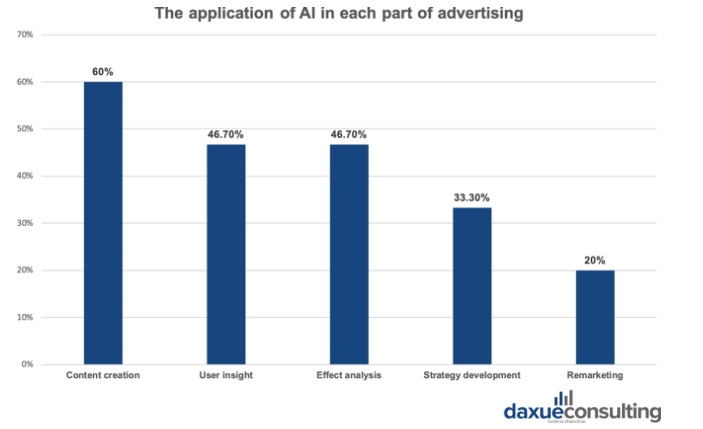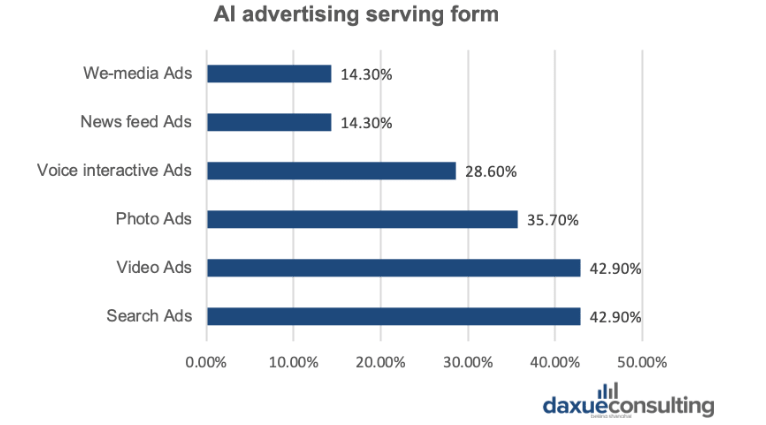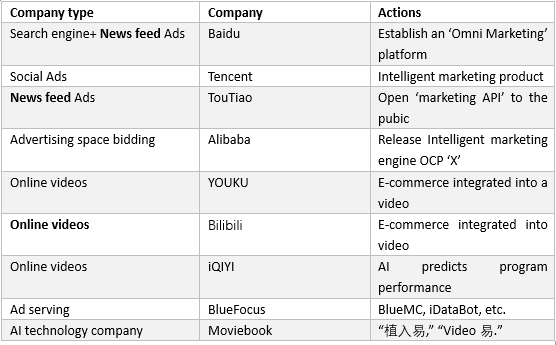AI in China’s Advertising industry: How is AI changing the future of advertising |Daxue Consulting
In 2016, the Chinese government committed its Three-Year Guidance for Internet Plus Artificial Intelligence Plan (2016-2018) focusing on economic improvement. 2016 was the first year of or AI in China’s advertising industry. Before this, advertising in China gradually completed the intelligence evolution of value war. The evolution consisted of three steps: In the 1.0 era, advertisers competed in the number of advertising resources and resource coverage; then, the focus of advertising in the 2.0 era shifted to the form and clarity of the display; Finally entered the 3.0 era of big data applications.
By 2018, the impact of AI on advertising in China is impressive. The size of the mobile advertising market in China had exceeded 400 billion, with a growth rate of nearly 50%. With the landing of AI in the Chinese advertising market, the realization efficiency of mobile advertising is effectively improved, leading to further growth of the advertising market.
Changes in China’s advertising industry – AI and Big data as new focuses
With the continuous development of the marketing industry, the traditional advertising model is no longer adapt to this environment. Under the premise of fragmented user time, problems such as unsatisfactory advertising ROI, and unclear target users are constantly magnified. At the same time, the viral delivery mode and single content form will inevitably cause users to have fatigue, which will reduce the interest in advertising. Additionally, the efficiency of media resources and traffic management urgently needs to be improved. To improve the effect of customer collection, and transformation, AI advertising in China combines technology with marketing to provide more creative content based on substantial user characteristics. AI advertising in China is at the frontlines in AI adoption and innovation. The application of AI in China’s advertising industry can bring richer user labels, more advanced crowd expansion technology and optimized click transformation of the target population. This effectively improves the advertising experience for both the advertisers and the target market by reducing unwanted ads and unwanted targeted audience members.
Several marketing pain points of China’s traditional advertising industry are: the balance between the amount of ads and the user experience; user engagement; user retention; product differentiation in the Internet media.
Therefore, advertisers are focusing on the role of data and technology to effectively solve the pain points in digital marketing. Currently, the majority of advertising spend is digital, and AI advertising in China thrives on massive data sets available in China.
The place of AI in the Chinese advertising market is throughout the whole process
According to a survey about AI in China’s advertising industry by ibaogao, 60% of advertisers have used AI for content creation. Besides, the proportion of ‘user insight’ and ‘effect analysis’ both equal to 46.7%. Meanwhile, other application landings that the main attempted have been “strategy development” and “remarketing.”

Thus, three stages of advertising with applications of AI in China’s Advertising Industry can be highlighted: the ad creation stage, the ad serving stage, and the ad detection stage. These three advertising phases also correspond to three dimensions content management, traffic management, and data management, respectively.
AI in Ad creation

The stage of ad creation includes hot topic matching, creative mass production, creative screening tests, and material integration and adaptation. With the application of AI in Ad creation, advertisers can realize the standardized production of primary creative ideas and quickly enter the release process: realize the automatic output of AI for standardized copywriting, design elements, graphics, text, etc.
An AI-powered system can create ads for advertisers. The function has appeared on some social media platforms. Based on the links you promoted, those platforms apply intelligent automation features to suggest which ads you should run.
AI-powered systems exists in some third-party tools that use smart algorithms to write ad copy for advertisers. These systems use two AI techniques: Natural Language Processing (NLP) and Natural Language Generation (NLG), to write ad copy in seconds.

Alimama is a Chinese data-powered marketing technology platform of Alibaba group. Based on the core business data and super media matrix of Ali Group, it empowers brands to provide products and marketing platforms with AI in Ad creation. In 2018, Alimama launched an AI copywriting product at Cannes international creative festival. It combined Taobao and Tmall’s massive amount of content with a natural language algorithm. Alimama has achieved three core competence-simulating human-written proposals, real-time online sample learning, and high writing quality. The production capacity of this AI product has reached an impressive 20,000 pieces per second.
AI in Ad serving
Ad serving is the process of advertisements disseminated to the audience. AI can help provide accurate communication and improve return on investment. AI in ad serving has three functions, namely scene identification, user identification and understanding, and advertiser identification.
Firstly, AI in Ad serving provides scene marketing power. This can be achieved by access more diverse data and modules, then providing richer user portraits for AI, to improve the accuracy of delivery and reduce budget waste.
Additionally, anti-cheating technology can identify the false traffic, thereby improving the transparency and authenticity of the delivery.

There are many combinations of AI in Ad serving forms. Among them, search ads and video ads are the most popular forms, 42.9% of advertisers choose them as the form of advertising.
Nowadays, video is the most popular ad carrier in China. Two mainstream video delivery methods include Big IP and DSP (Demand Side Platform). Big IP is now the core of brand advertising in the video field, such as TV series advertising. Big IP creates a lot of traffic, but the cost of sponsorship is extremely high. The other method is DSP, also known as the precision crowd. It sends ads directly to the audience who want to see them. DSP has a relatively high-cost performance for the accuracy of the crowd. However, it only has the dimension of the user label, so it cannot accurately locate the placement of ads.
Context marketing in China uses AI to achieve effective advertising
Context marketing refers to the marketing behavior of consumers’ psychological state or demand in a specific, realistic scene, so as to effectively achieve the goal of companies. A new form with AI advertising in China is called ASMP (AI Scene Marketing Platform) system launched by Video++. The system uses AI technology to structure the accumulated video content. It can complete brand exposure, product introduction, and one-click purchase functions in videos. In specific video scenarios, users’ emotional resonance will be stimulated to maximize the effective improvement of conversion rate and expand the income of advertisers.
Compared to traditional online video advertisements, AI scene advertisements can add about 40% of advertising space resources and an average increase of click rate of 2.5 times. It is estimated that the future AI scene advertisements can bring 31% value enhancement to the online video advertising industry.

Buying services while watching videos are provided by Chinese short video platforms. The charging mode includes charging commissions for e-commerce platforms, clicks, and collection of payments for the implementation of the project. AI advertising in China first took effect on short video platforms and live e-commerce broadcasts. However, applications and business models in the long video platform, OTT and other fields have yet to mature.
Brands can set different advertising forms to be embedded in video content according to their own communication needs. Applying AI to provide high-quality solutions for video content marketing and truly complete the seamless connection between brand and content.
The ASMP system links the user’s emotion with content relevance. It enables the audience to have emotional resonance after seeing the advertisement, which makes the advertisement more meaningful and effective. This is the best-case scenario for advertisers.
AI in Ad detection
The main task of Ad detection is to test the advertising effects.AI in Ad detection can help to manage data and traffic. Three aspects of AI advertising in China can be applied: online public opinion detection and analysis, automatic analysis of we-media data, and filtering of malicious and false traffic.
For example, in the process of advertising review on websites. Poorly targeted advertisements often appear in search engines along with malicious behaviors that collect user information, leak user privacy and threaten user security. AI in Ad detection can not only realize efficient information screening at the entrance but also automatic verification and process all links of advertising promotion by aiming at the illegal words and the constantly changing argumentation words.

At present, Baidu has used Baidu brain to build a machine recognition model by extracting text and image information from the page. Through the treatment of variant words simulation, trademark knowledge base, and risk word mining, it severely cracked down on non-industry medical promotions and other violations.
How to partner with leading advertisement AI companies in China
AI in the Chinese advertising market: Consolidate developing advantages through ‘AI+’
The core of advertising effectiveness is user understanding. Therefore, data becomes a basic competitive barrier in AI+ Ad marketing, as it is the foundation of AI advertising in China to help gain consumers insight and analysis. In terms of companies engaged inAI in the Chinese advertising market, B2C content or service platforms have a natural advantage in user data. On the other hand, B2B’s AI companies and advertising companies need to enhance customer data access capabilities and rely on accumulated data to optimize delivery capabilities.
The impact of AI on advertising in China. With whom to collaborate?
Because of the impact of AI on advertising in China, Chinese mainstream Internet companies and advertising companies have long been deployed in AI+ marketing. They have used AI technology to enrich media assets and optimize delivery effects in the original development advantages. On the other hand, it is open to customers and empowers its capabilities directly to clients in the platform ecosystem.
Most SMEs adopt the ‘production + sales’ model, and the demand for marketing is relatively simple and flexible, such as in e-commerce operations, SEO, social media promotion, H5 production, offline event planning. In addition, with the impact of AI on advertising in China, many startups are keen to create new consumer experiences that will use new technologies such as AR, VR, and face recognition.
Large B2B companies in the Chinese advertising market generally have higher advertising and marketing budgets, and their demand is concentrated on promotional videos, offline meetings, and offline advertising. Such companies generally choose stable, high-quality suppliers, and production companies to collaborate.
Large B2C companies using AI in Chinese advertising are high-quality customers competing for advertising agencies and traditional media. The advertising budget is sufficient, and the creative, production and distribution channels are biased towards the high-end. With the rise of Internet media, a significant portion of the budget for such companies has moved online, while the need for user portraits, data, strategies, and real-time monitoring has increased. Their partners are generally 4A, local interactive marketing companies, media distribution tools developed by major technology companies and advertising technology companies, big data-based AI strategy providers, etc.
The following are the leading AI companies in the Chinese advertising market.

Author: Rita Fan
We have a whole wealth of AI research to share. You can see it all in our AI in China White Paper.










![[Podcast] China Paradigm 39: How to run a successful social commerce campaign in China](../wp-content/uploads/2019/05/China-podcast-social-commerce-campaign-150x150.jpg)




